Globe
![]()
The title of this article is ambiguous. For other meanings, see Globe (disambiguation).
In cartography, a globe (plural: globes; Latin for sphere) is a reduced, spherical model of the earth (terrestrial globe or Latin globus terrestris), a celestial body or the apparent celestial sphere. Accordingly, a distinction is made between celestial globes and planetary globes (terrestrial globes and globes of "planets" close to the Earth: usually the Moon, Venus or Mars). Celestial globes, which show the starry sky on the apparent celestial sphere (apparent starry sky), have an older history than terrestrial globes. Until the 19th century, globes were usually made in pairs: An earth globe and a matching celestial globe.
Globes and aerial photographs belong to the map-related representations. Globe-related instruments are armillary spheres, planetaria (planetary machines, telluria (a special case of the Orrery planetary machine - a planetary machine of the Earth)). However, an armillary sphere, despite its spherical shape, does not represent a globe, but was used to measure coordinates in the sky or to represent the movement of celestial bodies.
The great advantage over a map is that the globe is simultaneously true to shape, area, angle and length. The map cannot fulfil these properties at the same time, since the surface of a globe cannot be rolled on a flat surface. Another advantage of globes is their vividness, for example, in depicting longer air routes and ship routes. Disadvantages of the globe over the map are inconvenient storage and transportation, higher price, usually smaller scale, and the impossibility of viewing the entire surface of the earth at a glance. When speaking of a globe, preferably an earth globe or colloquially the earth itself is meant (example: "to travel around the globe").
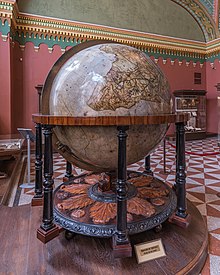
Earth globe - Blaeu globe in the State Historical Museum in Moscow

Celestial Globe

A celestial globe by Coronelli in the State Hall of the Austrian National Library in Vienna
Structure and manufacture
In the past, the globe usually consisted of two hollow hemispheres made of papier-mâché. The globe body was then assembled from the hollow hemispheres. This manufacturing process was most common from the 16th century until the 1950s. Until the end of the 19th century, the papier-mâché globe was also covered with a thin layer of plaster, which was sanded quite smooth. In order to reduce the price of production, the traditional plaster coating was then dispensed with.
Inside, the globe was reinforced by a wooden rod, through which the axis of rotation was also passed.
Globe Map Network
The globe only reproduces the ideal globe, but not the earth's figure (geoid) with the earth's oblateness, because with a value of 1:300 of the equatorial diameter on a 30-cm globe it is only 1 mm. Modern globes usually have a coarse grid of longitude and latitude circles at intervals of 10°, in smaller globes also at intervals of 20° or 30°. Furthermore, the equator, the tropics and the polar circles are usually drawn in.
Globe scale and size
The globe scale is the scale of a globe. Globes with a diameter of 26 cm have a scale of 1:50 million. With a diameter of 51 cm the scale is 1:25 million. The typical scale for an earth globe is 1:40 million.
Depending on the size and type of globe, it is called a pocket globe, table globe, standing globe or giant globe. A common table globe has a diameter of about 25 to 30 cm.
Probably the smallest globe with a diameter of 60 micrometers was introduced in February 2004 by the Japanese company NTT DoCoMo.
In the course of history, numerous larger globes or pairs of globes (terrestrial and celestial globes) were built for kings and royal houses. In more recent times, large globes serve as advertising media and eye-catchers.
Here follows a listing of giant globes, sorted by diameter:
| Diameter | Comment |
| 1,75 m | A pair of globes created by Vincenzo Coronelli for the Duke of Parma. |
| 3,00 m | The Great Globe of Swanage, consisting of 15 pieces of stone, is one of the largest limestone globes in the world. |
| 3,00 m | In the Piazzale del Impero in Rome, at the Fountain of the Spheres, there is the largest globe made of one piece of natural stone, made of Carrara marble |
| 3,11 m | Gottorf giant globe - built 1650-1664 by Adam Olearius in Schleswig for Friedrich III of Schleswig-Holstein-Gottorf (1597-1659); The globe was rotatable and walkable. Outer shell earth globe and inside celestial globe. |
| 3,84 m | A pair of globes by Vincenzo Coronelli created for the French King Louis XIV, now in the possession of the French National Library. Since the beginning of the 20th century, it had been stored in the Orangerie of Versailles, in need of repair. After restoration, it has been on display in the West Hall of the library since October 2006. |
| 7,75 m | Giant globe by Vandermaelen, Philippe M.G. (1795-1869) - a globe was exhibited in Brussels in the "Établissement Geographique de Bruxelles" founded in 1830. This globe could be reproduced if all 386 maps of the "Atlas universel de géographie physique, politique, statistique et mineralogique" were assembled. This atlas was the first to show all the maps at the same scale, the maps show only the land mass. Printed in Brussels between 1825 and 1827, first atlas printed entirely in lithography (by Henri Ode). |
| 8,53 m | Giant globe at Babson College in Wellesley, Massachusetts (rotating, 26 t; open air) |
| 10 m | Globe of Peace (Mappamondo della Pace) in Pesaro, Italy. It was the world's largest globe until 1999. |
| 10 m | Mercateum in Königsbrunn in the district of Augsburg. It is the largest globe in the world based on historical cartography. |
| 12,52 m | The world's largest rotating globe is Eartha. It has a diameter of 12.52 meters, a weight of 2721 kg and a globe scale of 1:1 million. It was built by the publishing house DeLorme in Yarmouth in Maine (USA) in 1998. |
| 36,57 m | Unisphere is a large globe located in Flushing Meadows Park in northern Queens, New York City (USA). |
The Mapparium in Boston is a three-story-high glass globe viewed from a spectator bridge. Another giant globe, made in 1930, stands in the lobby of the Daily News Building in New York.
Other important or well-known globes
- St. Gall globe from the 16th century, a combination of terrestrial and celestial globe
- Two globes for Louis XIV by Vincenzo Coronelli (Earth and Sky), today in Paris
- Globus Jagellonicus - made in France around 1510, today exhibited in the Museum of the Jagiellonian University
Special forms
There are also free-floating globes (Schwebeglobus), which are kept floating in space with the help of a mechanism made of magnets. For the representative public area, Luxesse was designed as a globe with integrated drive, which rotates optically free-floating in a column of cast acrylic glass.
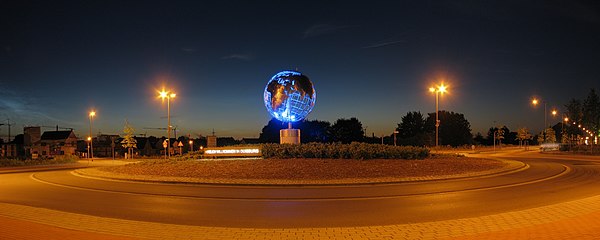
enlarge and show information about the picture
![]()
In Duisburg, numerous globe sculptures commemorate Gerhard Mercator; this one stands at the southern entrance to the city in Huckingen.
Frame
The old globes were traditionally mounted on expensive, four-legged wooden stands. In more recent times, with mass production, people switched to mounting globes on the cheaper column mount with a round base (round foot, "trumpet foot"). The scientific function of the globes was lost at the end of the 19th century, which is why the globe frames were also reduced considerably. (see below: The globe as a scientific instrument)
· 
Globe with four-legged frame. The compass at the base is easy to see.
·
Globe on vertical earth axis (Paris, around 1890)
·
Globe with swivel-pivot mount
The old traditional holders for the large standing globes consisted of a wooden horizontal ring (equator ring) resting on four feet. The globe lay half above and half below the equator ring. On top of this equator ring was another ring mounted vertically - the meridian ring. In the beginning, the meridian ring was also made of wood, but in later globes it was usually made of brass and could be rotated within the equatorial ring. The globe was mounted in the meridian ring by means of an axis of rotation. This construction allowed the globe to be turned and swivelled in all directions, so that it could be positioned in such a way that any two places on the globe came to rest on the equatorial ring. The equator ring usually carried several scales for angles, hours and distances. These could then be read directly between any two locations on the globe after the desired positioning of the globe. The equator ring and meridian ring on globes are called the armature. Also included in the armature is a compass (usually a dry compass), usually mounted between the feet of the frame.
In addition to the armouring, the equipment of older globes sometimes includes a flexible strip of brass, which is used like a ruler on the globe. This is used to measure the distance between two points that are not on the equator or on the same meridian.
The frames of the old globes also had a decorative aspect that should not be underestimated. The Atlas figure is a popular motif that is occasionally integrated into holders of antique globes. Atlas is a Greek giant who carries the vault of heaven on his shoulders.
Widely used is the bogie, where the globe is fixed by means of an axle running through its two poles. The globe is rotatably mounted on this axis. This axis of rotation, which is mounted on a pedestal, is usually inclined at 23.5° to the vertical in order to illustrate the orbital plane (ecliptic) of the earth around the sun. This also allows the course of the seasons and the course of a day to be demonstrated more clearly. Older globes, however, sometimes have an exactly vertical axis of rotation.
Rarer are globes with a gimbal suspension.
Rolling globes have a globe resting loosely on a base in two crossed quadrants. The measuring scale on the quadrant allows distance measurement between any two points on the earth. The measuring scale is often scaled with several units (nautical miles, hourly scale, angular scale).
Some high quality modern globes have a "date calculator" on the tripod to accurately set the position of the earth and the position of the sun for each day of the year and for each time of day.
Globes with a swivel-pivot mount can be rotated in all directions. Here, the internal rotation axis of the globe does not pierce the two poles, but it is held by a lateral swivel arm that "pierces" the globe in the equatorial region. To allow the swivel arm to pierce the globe at the equator, the globe is divided into a northern and southern hemisphere. Between them is a gap several millimeters wide, through which the swivel arm coming from the side is guided to the internal globe axis.
Standing globes have a frame that is designed according to the principle of the standing man. Due to the heavy, rounded base, the frame with the globe always straightens up after it has been pressed down.
Segment technology
Until the introduction of plastic globes, hand-laminating globes was the only manufacturing process. In this traditional handcrafting technique of globe production, globe segments are laminated by hand onto a sphere (covered with the map) and sealed with varnish.
In order to avoid overlapping errors, the non-distortion-free segments are chosen to be as narrow as possible, the spherical two-corners (the globe strips; Engl. gores ) usually cover 30° difference in length. Thus, the globe is usually covered with 12 gores cut out with cutting punches. Care is taken that the intersections of the slightly overlapping globe segments do not lie on the marked meridian lines, but close to them. In the case of very large globes, these bicorns are divided again at the equator. At the poles, an additional circular piece of map is often glued on (polar calottes) in order to hide any unclean overlaps at the point where the 12 segments meet.
The maps of the globe segments, for example, are printed in the cross-axis distance-spread azimuthal projection.
In the past, map segments created by hand were attached to a wooden sphere (which, however, easily warped in the course of time) and thus assembled to form a globe.
Thermoforming
Today, plastic globes are mass-produced from thermoplastics. A plastic plate is printed with a distorted map image (distortion print) and formed into a hemisphere by heat in a pressing machine, whereby the distorted map image is brought into the undistorted form. The protruding edge of the plate is cut away and the separate hemispheres for the northern and southern hemispheres are joined together to form the globe.
In another manufacturing process, a plastic film is printed with the distorted card, then deep-drawn by means of vacuum and then back-injected with acrylic under pressure. Also the back-lining of the thin deep-drawn foil with hard foam is used.
Globes are also made from acrylic and rarely from glass.
Although today the deep-drawing technique is the dominant method in globe production, the more expensive hand-laminated globes continue to be produced.
Modern cardboard globes
For the production of modern globes from cardboard, a foil printed with the map image of the northern hemisphere or the southern hemisphere is glued to a layer of cardboard and then punched out.
Together with a second layer of punched-out cardboard of the same shape and with an adhesive layer in between, everything is pressed together in a press under additional heat to form a hollow hemisphere. The edges of the hemisphere are about one to two centimeters longer than necessary for the later globe. This slightly too long edge of the hemisphere is cut off exactly along the equator, as this allows the greatest accuracy to be achieved. Finally, the northern hemisphere and southern hemisphere of the globe are put together, with an additional cardboard ring about two centimeters wide glued into the globe along the equator for reinforcement. This ring gives the globe additional stability. Finally, the narrow butt joint between the hemispheres along the equator is glued with a narrow adhesive tape, which is also provided with a length scale.
· 
Template for the globe half - before pressing
· 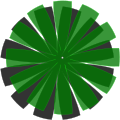
two stencils are placed on top of each other - rotated by a few degrees
Major manufacturers
- Columbus publishing house Paul Oestergaard in Krauchenwies
- Ludwig-Julius Heymann
- Räthgloben 1917 publishing house in Leipzig
- Simon Schropp & Comp.
- Ernst Schotte
- Dietrich Reimer
Cartridges
Like many historical maps, especially older globes have a more or less decoratively designed cartouche showing the title and possibly the name of the author, publisher, scale and/or year of production.
In the upper or lower half of a dedication cartouche it is written to whom this globe is dedicated (often to a king or other ruler). Since this ruler is not always known at the time the globe is made, this half of the dedication cartouche is often left blank for the time being.
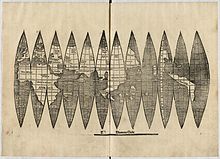
Two corners for the terrestrial globe by Martin Waldseemüller (after 1507)
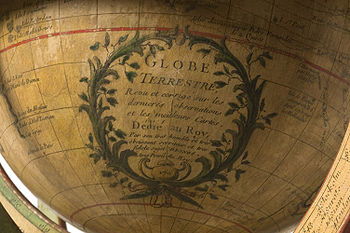
Cartouche - with a dedication in the lower half: "Earth globe - reviewed and corrected according to the last observations and the best maps - Dedicated to the king - by his very submissive and very obedient servant and very loyal subject Desnos. With the King's privilege. - – 1765“

Walkable giant globe Great Globe by James Wyld ("Georama")
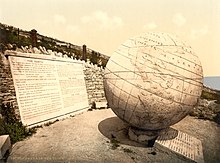
"Great Globe" made of limestone in Durlston Country Park in Swanage (England) from 1887.
Various globe types
There are globes of the constellations (celestial globes), the moon and other planets.
Earth globes are divided into physical globes and thematic globes. Physical globes are designed like geographical (topographical) maps. Some also show the ocean floor as a geographical map.
Thematic globes are mainly the political globes. But there are also thematic globes about the geology of the earth, geotectonics, climate, economy or traffic.
Manuscript Globes
Manuscript globes (from manuscript or handwriting) were hand-drawn globes in which all inscriptions and entries were also made by hand. They were not handwritten print copies that were later to be reproduced by printing. These manuscript globes were individual pieces. Only much later did serial production and then mass production of the globes follow.
Some globes were made on stone, metal or ivory spheres. On such solid globes the map image is sometimes plastically highlighted. They may be engraved or painted. Mostly, however, the map image was glued on from strips of paper. Solid wooden spheres or hollow wooden hemispheres were also used.
School globes
The school globe was used as a teaching and visual aid for school lessons, also for explaining and illustrating geographical phenomena (rotation of the earth, position of the sun, tropic of revolution, polar night, Coriolis force, time zones, sundials, great circles and great circle navigation, etc.). In Austria, globes were used as teaching aids in general schools from 1870 onwards.
A special version is the dumb globe, on which only the earth's grid of degrees, the contours of the continents, the largest rivers and all national borders are drawn, but no labelling (country names, city names, geographical designations) or geographical information. On these globes, which have no actual map content, various facts can be drawn for teaching purposes, e.g. with chalk or felt-tip pen. There are also dumb globes on which only the outlines of the continents (without country borders) are drawn. On other didactic globes, the continents and the oceans are clearly separated by colour to illustrate the relationship between the world's oceans and land masses. There are also school globes on which only the individual continents are shown in different colours.
Another version of the dumb globe is the induction globe, which only shows the degree network of the sphere, so that physical-mathematical relationships can be explained well on it. The induction globe was invented by Joseph August Brandegger in Ellwangen and served as a practical introduction to mathematical-geographical teaching.
· 
Table globe in geography class 1943 with applied analemma
· 
Pupils at the school globe 1951
· 
Induction globe with degree network
· 
Induction globe with degree network as well as mute map of the coastlines of the continents
Glow-in-the-dark globes
The company Räthgloben 1917 Verlag sold possibly the first illuminated globes in 1921, which were made on a glass sphere and illuminated from the inside with electric light bulbs. From the 1950s onwards, illuminated globes were then offered as duo globes, which had additional map information on the inside that became visible when the lighting was switched on. Depending on the manufacturer, the globe would show the political or physical map image when unlit and the other map image when lit. Depending on the manufacturer, they are also called double-image illuminated globes, two-image illuminated globes or double-illuminated globes
Duogloben is also available in a version with day and night display.
Another variant of the illuminated globe is the alternating image globe, in which the earth globe and the celestial globe are combined in a single globe.
Digital globes
Digital globes, also known as virtual globes, have been modeling the Earth in three dimensions since the late 20th century. Unlike the traditional analog globe, digital globes have a seamless, distortion-free map image. They can achieve a much higher resolution map display than conventional real globes. They are much more up-to-date, interactive and scalable. Examples of virtual globes are NASA's World Wind globe, Google Earth, Marble or National Geographic's 3D globe.
· 
Digital Globe NASA World Wind
· 
Virtual globe in Marble
Projection globe
Since April 2007, the Swiss Science Center Technorama in Winterthur has had the "Orbitarium" mega-globe. High-resolution videos with animations are projected onto the 1.5 m globe, for example the passage of hurricanes, ocean currents, the change of seasons, the migration of the magnetic pole or global air traffic.
Hyperglobes
A "hyperglobe" is a multimedia globe that is computer-based and linked to the Internet and can be interactively designed by the user. This virtual globe can be designed with integrated texts, images and animations tailored to the user's needs.
Palaeogloben
There are so-called paleo globes, in which, taking into account the theory of earth expansion, which states that a few hundred million years ago the earth was only half the size it is today, the earth is represented accordingly. Alfred Wegener concluded from the exact fit of the coastlines of South America and Africa that they must once have formed a larger continent together. He reconstructed a supercontinent called Pangaea, which included all known parts of the earth and protruded from the world's oceans. Paleo globes and computer animations show that today's continents can be used to almost completely close a much smaller globe. The first paleo globes were made by Christoph Hilgenberg.
Other globe types
Relief globes show a strongly exaggerated relief of the large mountain ranges. For example, if the relief of the mountains were reproduced to scale, Mount Everest would only have a height of 0.5 mm on a globe with a diameter of 60 cm. Since the inscription on relief globes is made on an uneven surface, it is difficult to read in some places. Mostly relief globes also show the sea relief. The superelevation can also be chosen differently for different altitude ranges. For example, up to 1000 m NN a 60-fold superelevation and above only a 40-fold superelevation, as well as a 40-fold superelevation for the relief of the oceans. A cheaper alternative to relief globes are globes with a smooth surface, where the mountains are only shown with relief shading. Tactile globes are also produced for the visually impaired.
Often the ocean currents are also shown on globes, differentiated by cold and warm ocean currents. There are also globes where, especially on the seafloor, the tectonic plate boundaries are additionally drawn.
· 
Relief globe of the moon
· .jpg)
Bathymetric globe made by Bruce C. Heezen and Marie Tharp
· 
Pocket globe made by Charles Price 1716
Pocket globes (also: miniature globes; English pocket globe, French globe de poche) have a diameter of 5 to 12 cm. They are usually transported and stored in a tin, box or case. Pocket globes can also be made of precious woods, for example mahogany or walnut, or of ivory.
The pocket globe is a special form of the pocket globe. It is a folding pocket globe, inside of which, for example, a small, removable armillary sphere is stowed.
In 1827 Caspar Garthe called a celestial globe made of two glass hemispheres, inside of which he placed a wooden globe.
Other types of globes are thematic globes (for example traffic globes - with drawn-in streams of worldwide shipping traffic), children's globes (with drawn-in typical animals of the region), globes made of precious stones or mother-of-pearl, designer globes, moon globes and the "Globus von Mecklenburg" by the Räth-Globen company, which appeared in the early 1990s (see also Rudolf Tarnow), an ironic allusion to outdated conditions in Mecklenburg.
Inflatable globes are especially used for very large models of the globe. Despite their enormous size, they are still easy to transport and still fit through normal doors when collapsed. If filled with gas, they can also fly as tethered balloons. Inflatable globes are sometimes also designed so that the water surfaces are transparent.
Climate globes show not only the continents but also a strong cloud image on the globe, similar to satellite images.
There are also satellite image globes, where the map image consists of satellite images, but without the representation of clouds.
A "cutaway globe" shows the inner structure of the Earth's mantle, crust and core. It can be partially opened to "see" inside the Earth.
A traffic globe shows the flow of goods and travel routes of air and shipping routes.
Well-equipped newer globes have additional functions, such as:
- Display of the subsolar point
- Day and night display
- Representation of the three twilight zones: civil, nautical, astronomical
- Equator Ring
Decorative globes can be attached to buildings for ornamentation and as a symbolic element, stand as decoration in representation rooms, in libraries or in the study of scholars. Globes are also occasionally used as a decorative element in combination with clocks or bookends.
Also, antique globes (facsimile, antique globe replica), antique style globes, or antique design globes are republished in simplified, cheaper versions. Genuine antique globes are sold through the art trade.
Map representations of the globe are:
- Planiglobus (plural: planiglobes) - this is the image of a hemisphere of the earth in a circular network.
- Planisphere - it represents the entire surface of the globe in a closed form.
Spherical cards
As an alternative to globes, there are spherically curved maps (globe segment). However, these spherical maps, which in a way represent an intermediate between globe and normal (flat) maps, did not find widespread use. Today, digital globes have made such spherical maps superfluous.
A convex (spherically curved) surface (spherical calotte) serves as the card carrier. In fact, these maps do not differ from a very large globe that has been cut into individual handy pieces. Just as on a globe, the representation on a spherical map is true to area, angle and length. Spherical maps can be cut out rectangular or circular.
On the one hand, this avoids the problem of projection distortion of planar maps, and on the other hand, the spherically curved map sheets (usually made of plastic) can still be stored and transported somehow practically, and it is cheaper than a globe. Thus, large bulky globes are not needed to display maps at larger scales without distortion. The dimensions of large globes are already problematic for transport because they do not fit through a normal door (about 1 m wide), if necessary large globes are disassembled into two hemispheres for transport.
For example, spherical maps were made for didactic purposes at the Science Museum of Minnesota in Saint Paul (Minnesota) in 1941, as part of an exhibition with the question: "Can America be bombed?". Several spherical maps were compiled into an "Atlas of spherical maps" that measured 22 × 25 inches (56 × 66 cm). The scale corresponded to a globe 3 m in diameter. On these spherical maps, the visiting public could take measurements of the range of bombers.
The US Army tested the production of spherical maps at a scale of 1:1 million ("design and production of spherical map sections displaying a portion of the globe at a scale of 1:1,000,000").
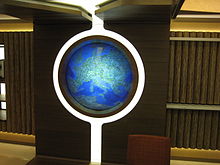
Interactive spherical globe
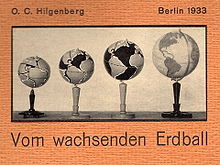
Hilgenberg's globes on earth expansion

Working with school globes in 1899
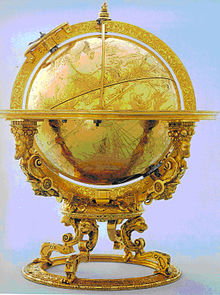
Mechanical celestial globe by Jost Bürgi
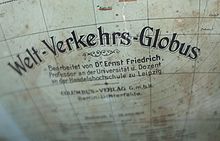
Cartouche of the world traffic globe in the Überseemuseum Bremen
Questions and Answers
Q: What is a globe?
A: A globe is a scale model with the shape of a sphere. It can be a scale model of the Earth (terrestrial globes) or other planets, or it can be models of the celestial sphere (celestial globes).
Q: Where does the word "globe" come from?
A: The English word "globe" comes from the Latin word "globus", which means round mass or sphere.
Q: What types of globes are there?
A: There are political globes that show countries and physical globes that show landscape like mountains and rivers. Additionally, some globes are star charts and some are maps of distant worlds.
Q: How do globes differ from flat map projections?
A: Globes have the advantage over flat map projections in that they avoid distortions.
Q: What does global mean as an adjective?
A: When used as an adjective, global means dealing with something on a worldwide level rather than any specific place on Earth. It is also used in fields like computers to mean dealing with a whole larger system, rather than its individual little parts.
Q: Are all globes maps of the Earth?
A: Most globes are maps of the Earth; however, there are also other types such as star charts and maps of distant worlds.
Search within the encyclopedia

